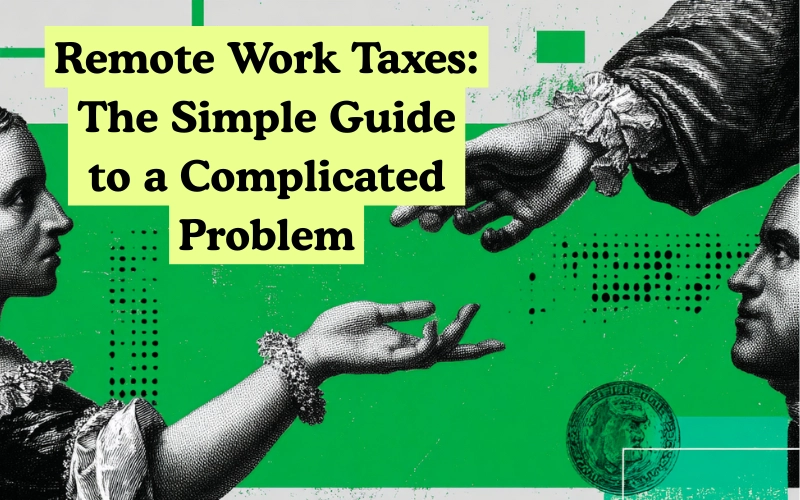Remote work created a tax nightmare nobody saw coming.
Your living room became your office. Your kitchen table became a conference room. And suddenly, you’re navigating tax laws across state lines.
Employers are discovering that a single remote hire in Colorado can trigger nexus obligations they never anticipated.
Employees are getting hit with surprise tax bills from states they barely visited.
The old rules assumed everyone worked where their company was headquartered. Those assumptions are dead. Multi-state compliance, double taxation risks, and conflicting residency rules are the new reality.
This guide cuts through the confusion with practical answers to the tax questions keeping remote workers and their employers awake at night.
What are remote work taxes?
Remote work taxes are the federal, state, and local tax obligations you face when working outside a traditional office setting. The complexity arises because tax rules weren’t designed for our modern distributed workforce.
Your tax situation depends on multiple factors: where you live, where your employer is based, where you physically work, and how long you spend in each location. Unlike office workers who typically face straightforward tax scenarios, remote workers navigate a web of overlapping jurisdictions.
Key tax considerations for remote workers:
- Federal income tax applies regardless of work location
- State income tax varies by state of residency and work location
- Local taxes may apply in some cities and counties
- Employer tax withholding requirements differ by jurisdiction
- International work creates additional compliance layers
The fundamental challenge is that tax codes across jurisdictions often conflict, creating potential gaps or double taxation scenarios that require careful planning.
How do federal taxes apply to remote workers?

Federal taxes apply to remote workers exactly the same as traditional employees — your work location doesn’t change your federal tax obligations. The IRS treats all U.S. income equally, regardless of where you earn it.
You’ll pay the same federal income tax rates, Social Security, and Medicare taxes whether you work from home in Montana or a coffee shop in Miami. Your employer continues withholding federal taxes from your paycheck using the same W-4 information you provided.
The main consideration is ensuring your employer has your correct address for tax document delivery. If you move while working remotely, update your address with HR to avoid delayed tax forms. Federal tax deductions and credits also remain unchanged, though some remote work expenses face different rules than traditional office deductions.
Do remote employees pay state taxes where they live?
Yes, remote employees typically pay state income tax where they maintain legal residency, but the complete answer is more nuanced. Your state of residency generally has the primary right to tax your income, regardless of where you physically perform work.
According to the Tax Foundation, 43 states impose individual income taxes, while seven states have no state income tax. If you live in a no-tax state like Texas or Florida, you may avoid state income taxes entirely.
State vs. Work Location Tax Comparison:
| Scenario | Residency State Tax | Work State Tax | Typical Outcome |
|---|---|---|---|
| Live in TX, work for CA company | None | None | No state tax |
| Live in NY, work remotely | Full rate | None | Pay NY only |
| Live in NJ, work in NYC office | NJ rate | NY rate | Credit prevents double tax |
However, complications arise when you work temporarily in other states or when your employer has nexus requirements. Some states may still claim taxing rights over income earned within their borders, even for remote workers.
What if I work in one state but live in another?

Working in one state while living in another creates potential dual tax obligations, but most states have mechanisms to prevent true double taxation. You’ll typically file as a resident in your home state and as a non-resident in your work state.
Your resident state will tax your total income but provide credits for taxes paid to other states. The work state may tax income earned within its borders. Most interstate workers end up paying the higher of the two state tax rates rather than the combined total.
The key is understanding each state’s specific rules. Some states tax based on where work is performed, others focus on where you receive payment, and a few consider where your employer is headquartered. Temporary work assignments typically don’t trigger non-resident filing requirements unless you exceed certain thresholds.
How do reciprocity agreements help prevent double taxation?
Reciprocity agreements eliminate the need to file multiple state tax returns by allowing you to pay income tax only to your state of residence. These agreements exist between neighboring states with significant cross-border commuting populations.
Currently, 16 states participate in reciprocity agreements covering specific state pairs. For example, residents of Virginia, Maryland, West Virginia, and Pennsylvania can work across these state lines without filing non-resident returns.
Under reciprocity, your employer withholds taxes only for your home state, even if the office sits across state lines. You file a single state return where you live, avoiding the complexity of multi-state filings and credit calculations.
These agreements don’t apply to remote work scenarios where you never physically work in the other state, but they become valuable if you occasionally visit offices or client sites across state lines.
What is the “convenience of the employer” rule?
The convenience of the employer rule allows certain states to tax remote workers as if they’re working in-state, even when working from home in another state.
This rule creates one of the most controversial areas of remote work taxation.
States with convenience rules:
- New York (most aggressive enforcement)
- Connecticut
- Delaware
- Massachusetts (suspended during COVID)
- Nebraska
- Pennsylvania (limited application)
New York’s rule is particularly strict: if your employer could provide you with an office but you choose to work remotely for your own convenience, New York taxes that income as New York-sourced. The burden falls on you to prove the remote work arrangement serves your employer’s business necessity rather than personal preference.
This rule can create significant tax bills for remote workers who thought they escaped high-tax states. If you work remotely for a New York company while living in Florida, you might still owe New York state taxes on that income, eliminating the tax advantage of your move.
When might I face double taxation as a remote worker?
Double taxation occurs when multiple jurisdictions claim the right to tax the same income, and you can’t fully offset one tax liability against another. Remote workers face this risk in several specific scenarios that traditional office workers rarely encounter.
Double Taxation Risk Scenarios:
| Situation | State A Claim | State B Claim | Risk Level |
|---|---|---|---|
| NY convenience rule + residence state | Work performed | Resident income | High |
| Temporary assignments >183 days | Non-resident income | Resident income | Medium |
| Multiple work locations | Source-based tax | Residence-based tax | Medium |
| International remote work | Foreign earned income | U.S. resident income | Variable |
You’re most vulnerable when working for employers in states with convenience rules while living elsewhere. Short-term assignments that cross state thresholds also create exposure, as does earning income in multiple states throughout the year.
According to the American Institute of CPAs, approximately 15% of remote workers face some form of multi-jurisdictional tax complexity that could result in double taxation without proper planning.
How do local city or county taxes apply?
Local taxes add another layer of complexity for remote workers, as cities and counties can impose their own income taxes separate from state obligations. These taxes typically apply based on where you live or work, depending on local ordinances.
Major cities with local income taxes include New York City, Philadelphia, Detroit, and numerous Ohio municipalities. Rates range from 0.5% to over 4% of income, creating meaningful tax implications for remote workers.
Remote workers generally owe local taxes where they maintain residency, not where their employer is located. If you live in Philadelphia but work remotely for a company in Austin, you’ll still pay Philadelphia’s local wage tax.
Some localities offer reciprocity with nearby jurisdictions, but these agreements are less common than state-level reciprocity. Always check local tax requirements when relocating for remote work opportunities.
What is the difference between domicile and residency for taxes?
Domicile and residency determine different aspects of your tax obligations, and understanding both concepts is crucial for remote workers who frequently relocate or maintain homes in multiple states.
Domicile vs. Residency Comparison:
| Factor | Domicile | Residency |
|---|---|---|
| Definition | Permanent legal home | Where you currently live |
| Number allowed | Only one | Multiple possible |
| Tax implication | Worldwide income taxed | Income taxed by presence rules |
| Change difficulty | Requires clear intent | Can change automatically |
| Documentation | Legal documents, voting records | Physical presence, local ties |
Domicile represents your permanent legal home — the place you intend to return to and consider your true home base. You can only have one domicile at a time, and it doesn’t change simply by living elsewhere temporarily.
Residency focuses on where you actually spend time and maintain connections. States use different tests to determine residency, typically involving days present in the state (often 183+ days) or maintaining a permanent place of abode while spending any time in the state.
How are W-2 employees taxed compared to 1099 contractors?
W-2 employees and 1099 contractors face fundamentally different tax structures, with remote work amplifying these differences across state lines. The classification affects withholding, deductions, and compliance obligations significantly.
W-2 vs. 1099 Tax Obligations:
| Tax Element | W-2 Employee | 1099 Contractor |
|---|---|---|
| Federal withholding | Automatic by employer | Self-estimated quarterly |
| State withholding | Employer handles | Self-managed |
| Social Security/Medicare | 7.65% (employer matches) | 15.3% (self-employment tax) |
| Business deductions | Limited home office | Full business expenses |
| Quarterly payments | Usually unnecessary | Required if owing >$1,000 |
As a W-2 employee, your employer handles most tax withholding and compliance, including navigating multi-state requirements if you work remotely across state lines. Your tax obligations remain relatively straightforward regardless of work location.
Contractors bear full responsibility for tax compliance, including understanding nexus rules in each state where they provide services. According to the Bureau of Labor Statistics, 36% of remote workers are independent contractors, making this distinction particularly relevant for the remote workforce.
What tax obligations do independent contractors have when remote?
Independent contractors working remotely face complex tax obligations that extend well beyond simple income reporting. You’re responsible for managing taxes across potentially multiple jurisdictions while handling business compliance requirements.
Self-employment tax hits contractors at 15.3% on net earnings, covering both employee and employer portions of Social Security and Medicare taxes. This applies regardless of where you work remotely, but state obligations vary dramatically by jurisdiction.
Remote contractor tax requirements:
- Quarterly estimated tax payments to avoid penalties
- Business registration in states where you provide services
- Sales tax collection if selling tangible goods or taxable services
- 1099-NEC reporting for clients paying over $600 annually
- Detailed expense tracking for business deductions
Some states require business registration and tax payments even for minimal contractor work performed within their borders. California, for instance, requires contractors earning over $600 in the state to register and potentially pay franchise taxes, regardless of their residence location.
Can employees deduct home office or remote work expenses?
Employees generally cannot deduct home office or remote work expenses for tax years 2018-2025 due to the Tax Cuts and Jobs Act suspension of miscellaneous itemized deductions. This represents a significant change from previous tax law that allowed home office deductions under specific circumstances.
The suspension affects only W-2 employees; independent contractors can still deduct legitimate business expenses, including home office costs, equipment, and supplies. This creates a notable tax advantage for contractor arrangements over traditional employment for remote workers.
Limited exceptions exist for specific employee categories. Armed forces reservists, qualified performing artists, and fee-basis state or local government officials can still claim certain work-related deductions, but these exceptions don’t typically apply to standard remote employees.
According to the National Association of Tax Professionals, 78% of remote employees incorrectly believe they can deduct home office expenses, creating potential audit risks for those who claim unavailable deductions.
What reimbursement options can employers offer remote workers?
Employers can provide tax-advantaged reimbursements for remote work expenses through accountable plans, allowing them to support remote workers without creating taxable income. These arrangements benefit both parties while staying compliant with IRS requirements.
Eligible reimbursement categories:
- Home internet and phone bills (business portion)
- Office furniture and ergonomic equipment
- Computer hardware and software
- Coworking space memberships
- Business supplies and materials
Accountable plans require employees to substantiate expenses with receipts and return any excess reimbursements. Payments meeting these requirements aren’t considered taxable income, and employers can deduct them as business expenses.
Reimbursement vs. Allowance Comparison:
| Method | Tax Treatment | Documentation Required | Employee Risk |
|---|---|---|---|
| Accountable plan | Non-taxable | Detailed receipts | None |
| Non-accountable plan | Taxable income | Minimal | Full tax burden |
| Fixed allowance | Usually taxable | None typically | Potential audit |
Some employers offer monthly technology allowances or stipends instead of reimbursing specific expenses. These arrangements typically create taxable income for employees but provide more flexibility in spending decisions.
How do employers handle multistate tax compliance and nexus?
Employers with remote workers must navigate complex nexus rules that determine where they owe taxes and face compliance obligations. Remote employees can trigger nexus in multiple states, creating administrative and financial burdens for unprepared companies.
Nexus generally occurs when an employer has sufficient connection to a state through employee presence, sales volume, or business activities. Even a single remote employee can establish nexus in some states, triggering income tax withholding, unemployment insurance, and workers’ compensation requirements.
According to Bloomberg Tax research, companies with remote workers in five or more states face an average of 40+ separate compliance requirements across jurisdictions. This includes payroll tax registrations, quarterly filings, and annual reconciliations.
Smart employers work with multi-state payroll providers and tax professionals to automate compliance. Some establish geographic restrictions on remote work to limit nexus exposure, while others factor compliance costs into their remote work policies and compensation structures.
What happens if I work remotely from another country?
Working remotely from another country creates international tax obligations that significantly complicate your tax situation beyond domestic remote work challenges. You may face dual filing requirements, foreign tax obligations, and complex exclusion calculations.
U.S. citizens must report worldwide income regardless of where they live or work, but the Foreign Earned Income Exclusion can shelter up to $120,000 (2023 amount) from U.S. taxes if you meet physical presence or bona fide residence tests.
International remote work tax considerations:
- Foreign country may tax your income as local earnings
- U.S. employer must handle withholding and reporting requirements
- Social security totalization agreements may prevent double coverage
- Foreign bank account reporting requirements (FBAR) may apply
- Tax treaty benefits might reduce double taxation
Your employer may face challenges with payroll compliance, work authorization requirements, and permanent establishment risks in foreign countries. Many companies restrict international remote work specifically to avoid these complications, limiting opportunities for location-independent workers.
Wrap Up
Remote work has transformed tax compliance into a maze of overlapping rules, conflicting jurisdictions, and unexpected liabilities. Employers face nexus risks from a single remote hire, while employees juggle multi-state filings and potential double taxation.
The old “one-office, one-tax” era is gone. Staying compliant now demands vigilance, planning, and expert guidance. By understanding these challenges, both employers and workers can navigate remote work taxes without costly surprises.
Ben doesn’t buy into “the way it’s always been done.” He’s spent his career challenging hiring norms and rethinking how remote work should feel. At Remployee, he helps create honest tools and opportunities for people tired of the gig economy’s empty promises.



